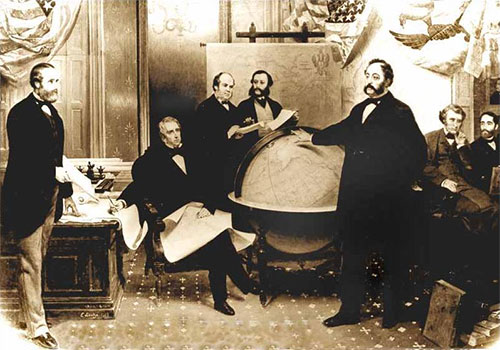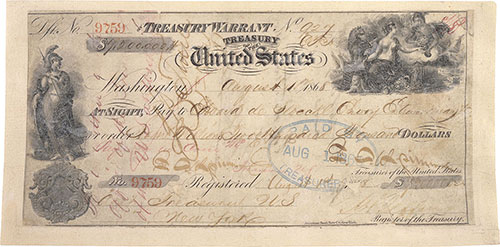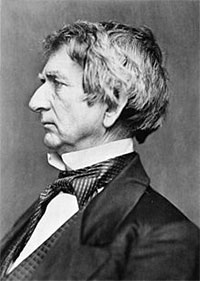
|
|||
4th United States Secretary of State - In office March 5, 1861 – March 4, 1869 |
Seward's most notable physical characteristic was his large "noble" nose, which he himself may have considered handsome. A proud and full profile photograph of him hangs in the Seward, Alaska, museum. In life, his nose definitely preceded him! He had a distinctive upper lip, an abundant head of hair, a passionate nature for causes, and a fierce determination.
His face carried the scars of an assassin's attack from the evening of April 14, 1865, when Abraham Lincoln was killed at Ford's Theater. Lincoln's assassination by renowned actor John Wilkes Booth was not a solo act but was a part of a much larger plot to kill the president, the Vice-President, the Secretary of State, the Secretary of War and perhaps others. However, some of the assigned assassins were less determined or trustworthy than others. The vice-president's assigned assassin got drunk to screw up his courage and passed out before he could act. The spared war secretary's potential assassin was never identified, a fact that fueled rumors that perhaps it was the Secretary of War himself who sponsored the deadly plans!
Seward was the only other target actually attacked in the assassination web. Seward had been rather seriously injured in a carriage traffic accident some days before and was lying in bed in the second story bedroom of his home on the evening of April 14. His attacker, one Lewis Paine (identified by other but similar names in several sources) arrived by horseback on the pretense of delivering medicine. Once in Seward's bedroom he brandished his pistol and pulled the trigger! But the gun misfired! Panicked, Paine pulled a knife and slashed at the bedridden Secretary of State. Seward's adult son, however, had heard the commotion, rushed into the room and pulled the attacker away. Paine clattered down the stairs and rode away - into a noose and a shameful historical footnote.
Two years later in 1867, at the time of the Alaska Purchase, the nation was caught up in the Go West Young Man fever of American expansion and the certainty of Manifest Destiny - the belief that the United States would one day stretch from the Atlantic to the Pacific shores. On March 1 of 1867 Nebraska was admitted to the Union as the 37th state. To come in the years following the Alaska Purchase were the states of Colorado, South and North Dakota, Montana, Washington, Idaho, Wyoming, Utah, Okalahoma, New Mexico, Arizona and, finally, in 1959, Alaska and Hawaii.
Seward, in negotiating the Purchase of Alaska, was working on a tight congressional schedule as well as a personal time crunch. The U.S. Senate was set to adjourn on Saturday, March 30, 1867. To Seward, his personal efforts toward the Purchase of Alaska were "now or never." The ambitious secretary of state had a dream even larger than Manifest Destiny - and there were Americans who joined him in his belief about the future of the United States. It was this: that the United States was destined to eventually occupy all of the North American continent above Mexico.

The signing of the Alaska Treaty of Cessation on March 30, 1867. L–R: Robert S. Chew, William H. Seward, William Hunter, Mr. Bodisco, Eduard de Stoeckl, Charles Sumner and Frederick W. Seward.
Photographer: Emanuel Leutze (d. 1868)
Canada was at that moment in
1867 deciding whether of not to initiate Consolidation.
If it did so, Canada would forever be connected to Mother England, and the U.S. would never be able to acquire that vast northern territory. But, if Consolidation failed and the U.S. acquired Canada, then to finalize the grand scheme, Alaska would be the "icing" on the tasty cake of North America! So - to Seward - the Russian possession's immediate purchase was essential! He sharpened his pens and his wits in approaching his session with the Russian negotiator.
Russia had entrusted the sale of its Russian-American lands to a member of its diplomatic corps, a dapper little gentleman named Edouard de Stoeckl, a man quite familiar with Americans and their culture after 25-some years as one of czarist Russia's most able representatives. The handsome and cultured de Stoeckl, a man of rather vague nationality, antecedents and titles - he fancied himself a baron - had married an American heiress and was quite ready to leave bumptious and muddy D.C. for the refinements and dancing slippers of gay Paris.
His mother country was divided on the issue of the sale of their North American lands. But it was the Czar who made the decision and he favored the sale - if the sale price was high enough. So de Stoeckl was charged with the sale, with a preferred sale price of no less than $5 million.
Russia had reason to sell Alaska. The bottom of the fur market had long since bottomed out and an otter pelt no longer commanded high prices on the Chinese market. And, in spite of strict Russian conservation demands, the sea otter populations had dwindled. Fur seal pelts from the Pribilofs still were profitable but it was not enough to justify the costs of manning and supplying Russia's American colonies. Agricultural attempts in the new lands had failed miserably from the start - imported Russian peasants were not happy in the primitive forests of Alaska or with its indigenous peoples. More importantly, Russia too believed that Manifest Destiny would drive Americans to the shores of the Pacific - and then north to Alaska!
A nervous de Stoeckl had finally been given the go-ahead for the sale in December of 1866. On short notice - just three months - he and his aides and secretaries found themselves closeted with Secretary of State Seward and his people on the night of Friday, March 29, 1867. The bargaining began in earnest! The Russian haggled the price up to $7,200,000, at which point Seward seemed reluctant to go any higher. Under the hiss of gaslights and billowing clouds of cigar smoke the two men wrote out provisions of a sale agreement. They argued and negotiated until four o'clock in the morning of Saturday, March 30.
Groggy but determined, that day, the final day before adjournment, Seward took his signed sale agreement to the U.S. Senate. Seward was no longer popular in the halls of Congress. His reception in the Senate was less than lukewarm. Few of the senators knew anything, or cared, about Alaska - it wasn't even contiguous to any existing U.S. territories!
We all know the names Alaska was called at the time: Seward's Ice Box, Seward's Folly, Walrussia, and worse. But maybe the senators were anxious to get on the road for adjournment, because after several votes, the Purchase of Alaska was a reality - by that one vote. What wasn't a reality was the promise of payment. It took Russia quite awhile to get its money, but eventually did. In the meantime, de Stoeckl and his bride moved to Paris for a comfortable retirement of French wine, French manners and Parisian entertainment.
William Henry Seward took a voyage to Alaska the following year, 1868, to see what his efforts had provided. His first stop was at Tongass Village at the mouth of Portland Canal. A totem pole was carved to commemorate his visit, a totem pole now defined as a shame pole, allegedly because he failed to provide gifts for a potlatch thrown in his honor. Maybe, maybe not. He returned to New York where he died in 1872.
Seward's Day is a holiday in Alaska to commemorate the U.S. purchase of Alaska from Russia in 1867. Later, Alaska Day celebrates the formal transfer of Alaska from Russia to the United States, which took place on October 18, 1867.
On March 30 of 2017, now 150 years after that memorable all-night session drafting the sale of Alaska to the United States of America, we Alaskans could again say, "THANK YOU, WILLIAM HENRY SEWARD!"
Editing by Mary Kauffman, SitNews
Related:
June Allen: Collector of Characters and the Character of Ketchikan By DAVE KIFFER
SitNews - April 07, 2016
This feature article was first published by SitNews March 21, 2003
In remembrance of June...
Copyright 2003
June Allen
All rights reserved.
Representations of fact and opinions in comments posted are solely those of the individual posters and do not represent the opinions of Sitnews.
SitNews ©2017
Stories In The News
Ketchikan, Alaska
Articles & photographs that appear in SitNews may be protected by copyright and may not be reprinted without written permission from and payment of any required fees to the proper sources.
E-mail your news & photos to editor@sitnews.us
Photographers choosing to submit photographs for publication to SitNews are in doing so granting their permission for publication and for archiving. SitNews does not sell photographs. All requests for purchasing a photograph will be emailed to the photographer.

